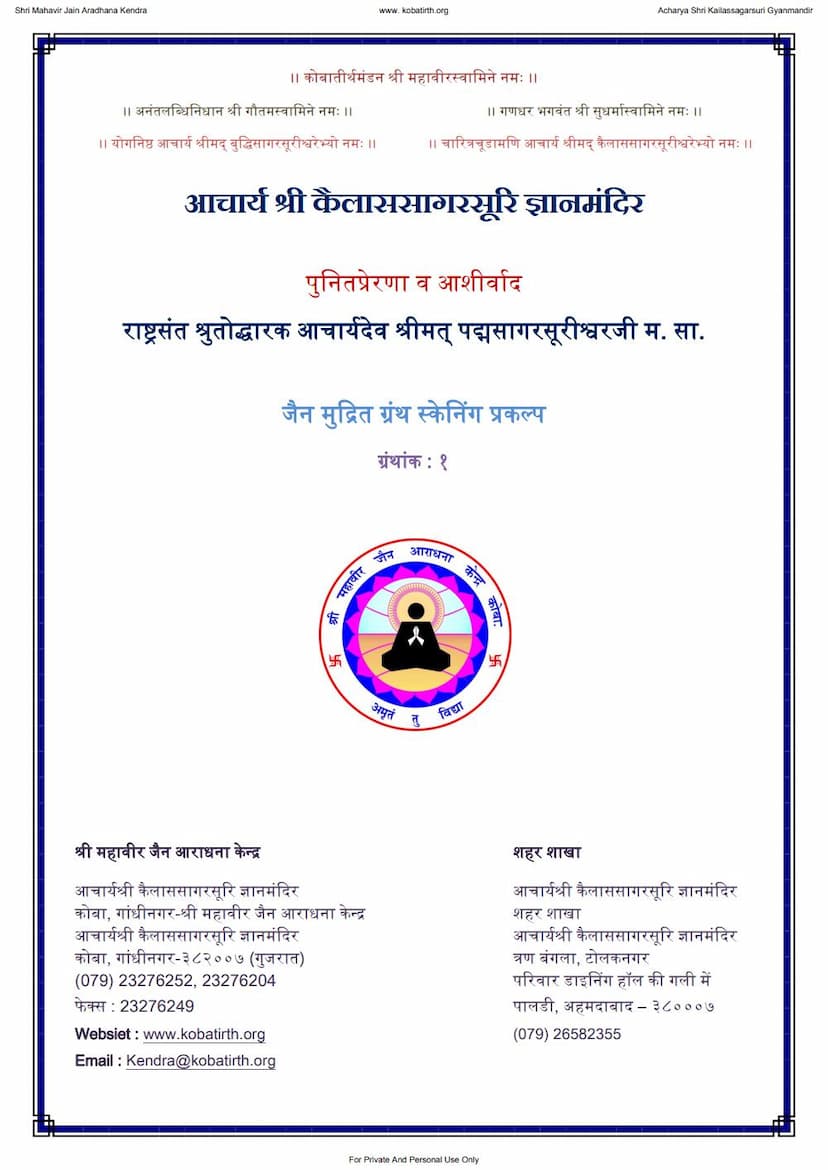Phit Sutrani
Added to library: September 2, 2025

Summary
This is a comprehensive summary of the provided Jain text, "Phit Sutrani" by Franz Kielhorn, based on the pages you've shared.
Book Title: Phit Sutrani (also referred to as Phitsutra) Author: Franz Kielhorn Publisher: Leipzig Publication Year: 1866 Context: The text is an academic work, specifically a scholarly edition of ancient Sanskrit grammatical rules concerning accentuation, presented with introductions, translations, and notes. The pages provided are from the introduction and the beginning of the text itself, with extensive commentaries in Sanskrit.
Overall Summary:
Franz Kielhorn's "Phit Sutrani" is a critical edition and study of a specific set of Sanskrit grammatical rules, the Phitsutra, attributed to the grammarian Çântanava. These rules focus on determining the accent (udâtta, svarita, anudâtta) of Sanskrit words, particularly prâtipadika (uninflected stem words). Kielhorn's work aims to provide a reliable text of these sutras, analyze their relationship to the more famous grammatical system of Pāṇini, and explore their historical context and linguistic principles.
Key Aspects and Content Breakdown:
-
Introduction and Scholarly Context (Pages 4-7):
- Purpose: Kielhorn's introduction sets the stage by discussing the significance of the Phitsutra within Sanskrit grammar, particularly its focus on accentuation, which was a vital aspect of Vedic recitation and pronunciation.
- Comparison with Pāṇini: A major theme is the comparison of Çântanava's rules with Pāṇini's system. Kielhorn highlights that Çântanava's approach is largely independent of etymology (vyutpatti), focusing instead on the word's meaning and form as presented in the language. Pāṇini, conversely, integrates accent rules with the etymological derivation of words.
- Textual Criticism: Kielhorn emphasizes the challenges in establishing an accurate text of the Phitsutra, mentioning the reliance on manuscripts and the need to correct errors found in earlier printed versions (like the Calcutta edition of the Siddhantakaumudi and Bohtlingk's work). He acknowledges the importance of various Indian commentaries, citing works like Bhattojidikshita's Praudhamanorama, Nagojibhatta's Laghucabdenducekhara, and others.
- Authorship and Dating: While the introduction discusses the difficulty of definitively dating the Phitsutra or pinpointing Çântanava's exact location, Kielhorn presents arguments for Çântanava living after Pāṇini, based on stylistic similarities and the nature of the rules. He also touches upon the debate of whether Çântanava belonged to the "eastern" grammarians (Prâncas), suggesting the evidence is inconclusive but leaning towards the possibility based on certain terminologies.
- Methodology: Kielhorn outlines his painstaking process of consulting various manuscripts and commentaries, indicating a deep engagement with primary sources. He expresses gratitude to scholars who assisted him.
-
The Phitsutra Text and Commentaries (Pages 8-41):
- Structure: The provided pages showcase the beginning of the Phitsutra text, divided into padas (chapters). Each sutra is presented along with detailed commentaries (Siddhanta Kaumudi - Si. Kau., Laghu Shabda Kaumudi - La. Sha., and Phitsutra Vritti - Phi. Vr.).
- Content Focus: The Phitsutra themselves are concise rules dictating the accent for specific classes of words. They address:
- Word Endings: Rules often specify the accent based on the final vowel or consonant of a prâtipadika (e.g., "the last syllable is udâtta," "the final syllable of words ending in ... is udâtta").
- Word Meaning: Accent is determined by the word's meaning, such as synonyms for "house," "sea," or terms denoting "skill" or "adulthood."
- Word Form/Classification: Rules consider categories like feminines, neuters, words derived from specific roots, words beginning with certain letters, names of flora, fauna, celestial bodies (nakshatras), geographical locations (janapada), and parts of the body (svânga).
- Specific Words: Many sutras list specific words or groups of words that are exceptions or follow particular accentuation patterns (e.g., dakshiņa, kṛṣṇa, śukla, gaura, aṅkuṣṭha, udaka, vaka, vaśā, pṛṣṭha, mṛṣṭa, arjuna, arya, āśā, nakṣatra, kṛttikā, ghṛta, jyeṣṭha, kaniṣṭha, bilva, tiṣya).
- Vedic Usage: Several rules explicitly mention application in the chandas (Vedic language) or specify exceptions in bhāṣā (standard language).
- Compound Words: Rules also touch upon the accent in compound words.
- Nipâta and Upasarga: There are rules specifically for the accent of particles (nipâta) and prefixes (upasarga).
- Commentaries: The Sanskrit commentaries are extensive and serve to:
- Explain the Sutras: Clarify the meaning and scope of each rule.
- Provide Etymologies: Trace the derivation of words, often referencing other grammatical works.
- Cite Examples: Illustrate the rules with numerous Sanskrit words, often quoting from Vedic texts (Rigveda, Atharvaveda, Vajasaneyi Samhita, etc.).
- Discuss Exceptions and Controversies: Address differing interpretations, grammatical debates, and apparent contradictions, referencing other authorities.
- Reference Other Grammatical Works: Frequently cite Pāṇini's Ashtadhyayi and other texts like the Uṇadisutras, Mahābhāshya, Kashikavritti, and Rigveda Pratisakhya.
-
Indices (Pages 96-102):
- Sutra Index: An alphabetical list of all the sutras presented.
- Term Index: An extensive index of Sanskrit terms used within the sutras and commentaries, cross-referenced with sutra numbers and sometimes with the source text (S. for Siddhanta Kaumudi, V. for Phitsutravritti). This demonstrates the depth of the scholarly apparatus.
Significance and Contribution:
- Preservation of Ancient Knowledge: This work plays a crucial role in preserving and making accessible vital rules of ancient Sanskrit accentuation from a less commonly studied but significant grammatical treatise.
- Linguistic Scholarship: Kielhorn's edition is a testament to the rigorous philological methods applied to Indian classical texts. It allows for a deep understanding of the principles governing Sanskrit accentuation.
- Historical Linguistics: By comparing Çântanava's rules with Pāṇini's, the work contributes to understanding the evolution of Sanskrit grammar and the different schools of thought within it.
- Vedic Studies: Accurate accentuation is critical for understanding and properly chanting Vedic hymns. This work aids scholars in the field of Vedic studies.
In essence, Kielhorn's "Phit Sutrani" is a scholarly monument, presenting a critical edition of Çântanava's rules on Sanskrit accentuation, meticulously annotated with extensive commentaries that delve into the intricacies of ancient Indian grammar and linguistics.